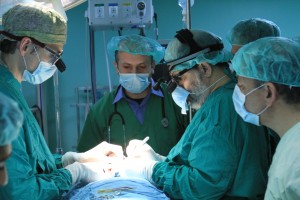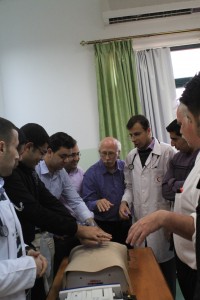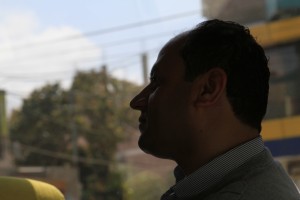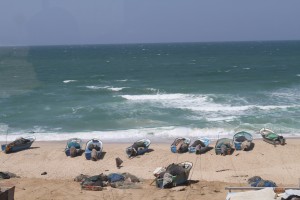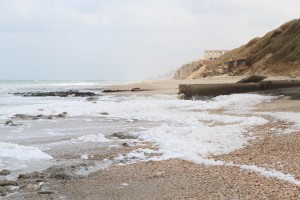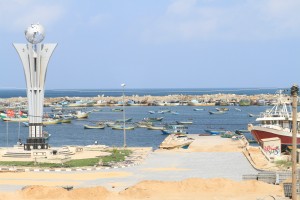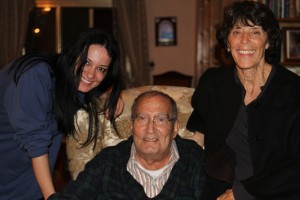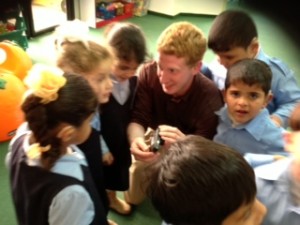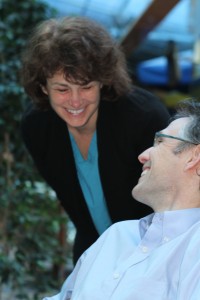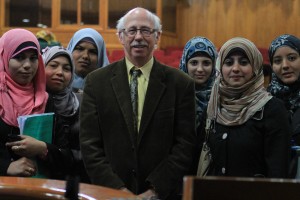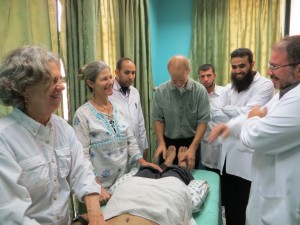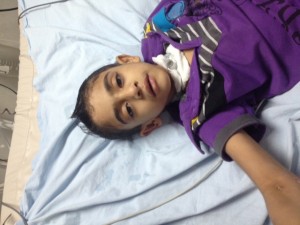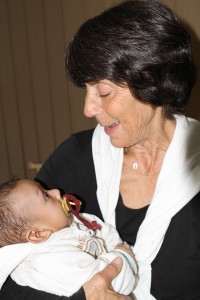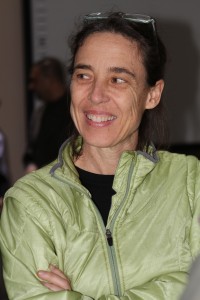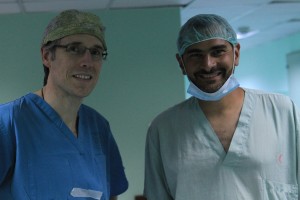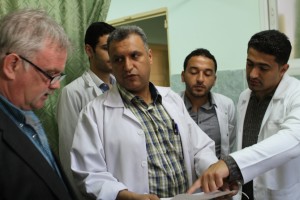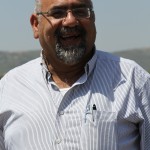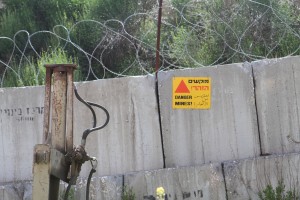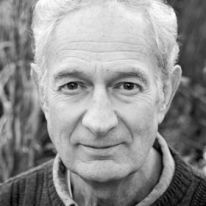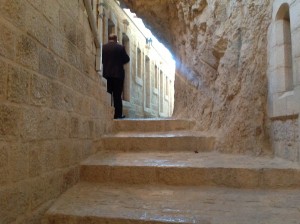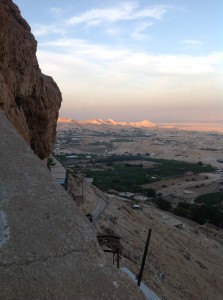(Gerri Haynes, former president of Washington Physicians for Social Responsibility, has returned to Gaza with a delegation of doctors, nurses and others interested in helping the people there. Gerri will be sending back reports.)
Following a good meeting with the Minister of Health and the Coordinator for International Activities this morning, Rich Grady returned to the hospital to work for another long day – each night, he has returned to the hotel near midnight having operated and instructed throughout the day. Bob Haynes and Bill Dienst spent this last day teaching Advanced Life Support to classes in two hospitals, completing a week of instruction for dozens of students.
This afternoon, Nikki Nichols and I met with a group of women in an impoverished area of
Gaza. I had met with these women in April 2012 and they assembled in a room just off the street – a room where their children roamed in and out – curious about the meeting their mothers were having. While I talked with the women, Nikki gave a chair massage to each of them. All of the women have experienced the death of a family member in one of the attacks on Gaza. Today, they talked about the effects of the siege on their lives. Here are their words:“The situation is getting worse. Food is too expensive – we cannot afford chicken. We cannot afford medicine. Unemployment is increasing. UNRWA (the United Nations Relief and Works Agency – organized to provide assistance, protection and advocacy for families in the Near East) is restricting services and we do not get enough food aid or money to be able to live. (Funding to UNRWA has decreased and there have been recent threatening protests at the UNRWA site in Gaza City.) If they cannot help us, they need to let us go back to our land (farmland in the NO GO zone which comprises one third of the arable land in the Gaza Strip). We need our government to come to peace with the Ramallah government so that they can work together to free us.”
“I work as a cleaner for 100 dollars/month. UNRWA told me that this is enough and quit giving aid to my family. I cannot feed my family of eight, pay school expenses (see below) and taxes for this much money. I don’t know about meat for my family – I only hear about meat. We were invited for a family nutrition workshop at ANERA – they told us to feed our children protein … we would like to do this, but we have no money for such things.”
Another woman said, “Even those who work in the government have had their salaries cut in half. We have become overwhelmed with loans and now suffer from debt we cannot pay. More people are committing suicide (strictly forbidden by Islam). The stress is too much.
During the last war on Gaza, her cousin was cooking in her home when a man from Hamas (being targeted by Israel) came in – a bomb destroyed their home, killing the whole family. Everyone has had a family experience with violent death during the attacks by Israel. They live daily with the fear of another attack – there is nowhere for them to go. Hundreds of civilians were killed or wounded in the November 2012 attacks and they and their children live every moment with the anxiety about another attack.
Because of the economic situation, the level of domestic violence is up – all of the women agreed with this observation. “Our children come to us for money (to be able to pay the fees for school) and because there isn’t enough money, my husband hits them. He is very, very frustrated.”
Medical problems in their children are not being resolved. “Two of my children stutter since the last war. They know about the Israelis targeting cell phones and that people are killed when the Israelis track a phone. The 13-year-old friend of a neighbor borrowed the phone of someone being targeted and the child was killed.
“My problem is no medicine. My seven-year-old daughter has epilepsy and there is no medicine to treat her.” Another woman said that since the war, her nine-year-old daughter has started wetting the bed and no one has been able to help her. “Our children cannot concentrate in school. They are hungry and there are nervous. Their academic achievement has become zero. As adults and parents we cannot help them. The curriculum is very difficult. The school day is short (double shifting) and we cannot afford to pay for the extra classes that are offered after school. Each of these classes costs ten dollars/month/child. We do not have that money. Our children go to school in Beach Camp – it is a very long walk, but we cannot afford to send them on a bus, so they walk through the rain in the winter and become very cold. We have to pay for uniforms for the school – we cannot afford to pay for these uniforms. We cannot afford food for them for school. At school, the water is polluted and we cannot afford to buy clean water for them. Because the electricity is off much of the time, our children have to study by candlelight – this is not enough light and it is dangerous. Many children have died in fires caused by candles.”
I asked about generators. “Generators – don’t remind us! We get mad (crazy) from the noise of the generators. Many people stopped using them because you have to buy fuel to run them and we cannot afford the fuel. When they are running, you can’t concentrate on anything – the noise is so loud. On the other hand, the dark is very scary. Our children stay in one room, afraid of the dark (and what it has brought in the wars.) My husband is working, but it is a very small salary and they take the fees for electricity from him. If he doesn’t pay the fees, we don’t have electricity, even when it is running. Today is a “free” day – we will have electricity all day long, but this is very rare.”
The women were clearly friends; their children played together as family; the air of frustration was strong. They wanted us to tell our government to help end the siege – to let the people of Gaza be free to find jobs and to work in their farms and to fish in the sea.
(Gerri Haynes, former president of Washington Physicians for Social Responsibility, has returned to Gaza with a delegation of doctors, nurses and others interested in helping the people there. Gerri will be sending back reports.)
Day Six in Gaza
Hospital Clinics and surgeries are closed on Fridays in observance of faith. We traveled by bus with friends from Gaza for a tour of this imprisoned land. Bordered by Israel, Egypt and the sea, Gaza has great beauty. Hamada Bayieri of UNOCHA (United Nations Office for the Coordination of Humanitarian Affairs) joined us for two hours to tell us about the challenges of living here. He welcomed us by saying that the people of Gaza have a feeling of isolation and that we are a contact to let people know they are not alone.Everything we witnessed demonstrated effects on the physical and mental health of the people of Gaza. Hamada reviewed the current statics of
living under siege, noting that 38 percent of the population lives in abject poverty. Fishing used to supply a primary source of protein – now most of the 3,500 fishermen do not fish. The Oslo Accords guaranteed a ten nautical mile border for Gaza, but Israel imposes a border at three nautical miles – making access to clean water and large fish impossible. Hamada noted that this lack of access is not only a matter of loss of “right,” it is a matter of loss of human dignity,Hamada commented that the people here continue to be resilient, but noted that crowding, poverty, lack of access to building materials and rising population density (increased demand in
the face of shrinking resources) create an atmosphere where gender-based violence is increasing and people consume most of their day trying to cope with the lack of life’s survival essentials. Eighty percent of the people in Gaza are aid-dependent.We stopped by the Sea to observe a large pipe carrying part of the 80 million liters of partially and fully untreated sewage into the Mediterranean each day. Walking on the shore, the smell was not pleasant, but the possibilities for the Gaza shoreline were obvious. The Mediterranean is a magnificent sea – the shoreline here is easily accessible. If the water could be cleaned and the sea could be freely
used, both the access for the people to the sea and the development opportunities are great. As it is now, the Mediterranean is polluted and not safe for swimming or fishing (as noted previously).Along the long land border with Israel, Israeli guard towers and the Wall were obvious. The area known as the “NO GO” zone is comprised of one third of all the good crop land in the Strip – this is 17 percent of Gaza’s 360 square kilometers. Israel guards this area with guns and even though the border was to be narrowed after the November 2012 attacks on Gaza, this narrowing has not happened. Farmers venturing into the restricted zone are shot. Since
November, four people have been killed and more than 100 wounded in this border zone.We observed some of the areas where goods used to enter Gaza from Israel. Now, there is only one crossing for materials and Hamada reported that since the 23rd of March this year, even this crossing has been closed more than 70 percent of the working days. This heightens the need and use of the tunnels between Egypt and Gaza. After Hamada left us, we ventured into the tunnel area at the Rafah border. The tunnels employ about 7,000 workers – many of them 15- 17 years old. Since the beginning of this year, ten people have been killed in tunnel collapses. We were able to enter the mouth of one tunnel, but access is strictly guarded.
Following a tour through the Rafah border (where passage to Egypt is severely monitored and not freely given), we returned to Gaza City.
A visit highlighted our evening! After receiving medical and surgical care in Jerusalem, our dear friend, Eyad Sarraj, has returned to his home in Gaza. We enjoyed a visit with him and knew again the wisdom of this founder of the Gaza Community Mental Health Programme.
(Gerri Haynes, former president of Washington Physicians for Social Responsibility, has returned to Gaza with a delegation of doctors, nurses and others interested in helping the people there. Gerri will be sending back reports.)
Day five in Gaza
In the Al-amal Institute for Orphans and in the Atfaluna Society for Deaf Children the dedication of the people of Gaza to their families is clearly evident. The orphanage serves children from five years to eighteen years of age. Most children of Gaza whose parents have died are taken care of by their families – even when the families are extremely poor. Some of the 100 children in the orphanage are not fully orphaned – they may be without a mother or a father but come from a situation where the remaining parent is unable to provide a home. The parent may visit the child but the orphanage assumes 24-hour care for the child and mainstreams them into the neighborhood for school.The facility is impeccably clean and each child is
taught to be responsible for his or her living area. We met with the Director of the orphanage and gave him some of the school supplies donated in Seattle. With war a constant threat and too-frequent reality, the Director told us there are 5,000 – 7,000 orphans in Gaza, served by two facilities and many families.Alfaluna, the institute for the care of deaf children is another inspirational organization in Gaza.
David Helfand writes:
“As adults we learn to hide our fear. We use bravado, humor, silence, and any number of other mechanisms to mask the psychological and emotional scars left by the struggles and traumas in our lives. Children are not such good liars. As a stranger stepping into a kindergarten class at the Atfaluna Society for Deaf Children, one might expect to be greeted with apprehension or fear. However, what I found was the opposite. The boys and girls stepped forward with wide smiles, eager to shake hands with us, some of them repeatedly. They posed for photographs, and then crowded around, jostling and pushing up against us to see the results. These children live in a place where life is a constant struggle and terror can and has ruled the day. With hearing impairments they face further challenges beyond those of their peers. Some might argue that they do not show fear simply because they are too young to know better or to understand the world around them. There may certainly be some truth to this idea. There is no way that siege, bombardment, poverty, and repression could possibly leave these children unaffected. But the fact that even in such circumstances the most vulnerable members of society can show such enthusiasm and appetite for life speaks volumes about the resiliency of the people of Gaza and the human race as a whole.”
We also visited the Water Authority to learn how Gaza is addressing critical issues regarding their water. The 1.7 million people of Gaza presently live with a diminishing supply of water – water that is 90 – 95% polluted. Plans for desalination and sewage treatment plants are complicated by the siege. Essential building materials are not available.
There is now only one crossing from Israel to Gaza and importation of building materials is strictly controlled. See the UNRWA report “Gaza 2020: A Livable Place?” for a picture of the environmental and humanitarian crisis facing Gaza.
(Gerri Haynes, former president of Washington Physicians for Social Responsibility, has returned to Gaza with a delegation of doctors, nurses and others interested in helping the people there. Gerri will be sending back reports.)
Day Four in Gaza
The complexities of politics are reflected in nearly all of life here. Living under Israeli siege and having extremely limited ability to move outside this 25-mile-long strip of guarded land and sea presents challenges to every citizen.We see more building and newer cars than one year ago, but are told by many that this reflects that a few are profiting, while climbing prices are making life even more difficult for the vast majority of people. The tunnel economy, regulated by the government, seems to be thriving, but the tunnels remain dangerous and we hear regularly about people being crushed in tunnel collapses.
There are two primary political parties here (Fatah and Hamas – with Hamas maintaining the government) and many small parties – not all of them working congenially or with basic agreements. Life is difficult. One agency director told us today that the siege is not only external but, because of the constant and continuous threat to life, the siege has also become internal.
This afternoon, planes flew overhead (always an ominous sound here) and the shudder of a bomb filled the air – this is such a common occurrence that when I asked several locals about it, they shrugged and said, “It is normal.” In the meantime, there is a folk festival tonight in Jabalyia Refugee Camp and four members of our group are headed there with local friends.
My great Kirkland neighbor, Susan, made forty boxes of delicious candy for me to bring to Gaza. Everyone who tastes this candy has a big smile – “thank you” to Susan for this yummy gift!Dr. Bob Haynes and Dr. Bill Dienst are continuing with classes in advanced life support. Today, they offered a class in the Islamic University School of Nursing (men and women students are segregated in this school, in classes as well as in the elevators).
The Islamic University has 800 nursing students (four year baccalaureate program) and 200 in the two-year midwifery program. Bob was told that all of the nurses will have employment when they graduate, but medical students look forward to 70 – 80 percent employment as physicians (after their internship year) and many will go abroad for specialty training.
Nikki Nichols writes:
“I came to Gaza to serve. Tuesday gave me that opportunity when we (two massage therapists and a chiropractor) worked together on a war-wounded man with low back pain. During the last war, Nov 2012, a rocket exploded near this man and shrapnel and debris invaded his body, destroying his intestines. Surgery left him without a spleen, only part of his intestines and a long scar from his neck to his abdomen.
“I did cross fiber friction on his scar and recommended that he do this regularly using Vitamin E oil (if it is available). Back surgery for his injuries left him with back pain that radiated down his leg to his feet. Our team massaged him while getting his feedback. At one point the patient was surrounded by about 10 people- our team of three, physiotherapists who work at the hospital (and with whom we enjoyed sharing knowledge), hospital administrators (including an interpreter), and representatives from the government‘s Ministry of Health. Lots of attention and healing energy was focused on the patient. I was glad to be part of the team!“Basman, the grant coordinator for the El Wafa Rehabilitation Hospital where we were working, was an excellent interpreter during our work. Basman lived in the USA for 45 years and said he is very happy to be home in Gaza. Looking out his office window, Israeli guard towers and the wasted fertile farmland that lies between the hospital and the Israeli Wall are visible. This land could produce food for hundreds of Gazans, people who are extremely short of food supplies, but it is in the “no go” zone – an area deemed too close to the Israeli Wall (for security reasons).
“El Wafa Medical Rehabilitation Hospital has lots of impressive equipment but some sits idle because of inability to obtain parts and maintain service due to the blockade. This hospital gets donations from many countries, not including the USA. It serves a population that is served by no other place in Gaza.
“We had an extensive tour of the hospital, seeing patients who demonstrated various effects of the blockade and wars. Some lay in contorted positions as they had been electrocuted while trying to obtain electricity from power poles for their families. Some had wounds from land mines and some had horrible wounds from road traffic accidents. I am thankful that El Wafa is present to serve this needy population.”
(Gerri Haynes, former president of Washington Physicians for Social Responsibility, has returned to Gaza with a delegation of doctors, nurses and others interested in helping the people there. Gerri will be sending back reports.)
Day Three in Gaza
Nearly every person I met today expressed sorrow over the bombing in the U.S. This kindness and concern over the tragedy at the Boston marathon was particularly tender from people whose land has been bombed so frequently and so recently.This afternoon, several of us visited Ard El Insan Child Nutrition Center. I’d read that the level of chronic malnutrition in Gaza is over 10 percent. The Center sees hundreds of children each day and has ongoing research regarding their nutritional status. The director told us they are noting that about 3.2 percent of children in Gaza have acute malnutrition and over 13 percent are chronically malnourished. Chronic malnutrition carries many ominous characteristics – growth stunting, diminished ability to learn, lessened immunity among them. The benefits of breastfeeding are emphasized and milk supplementation for infants is strongly discouraged. Dr. Adnan came to Gaza on a temporary job assignment in 1987 and has remained – the work and the people being too compelling to allow him to leave. His work is internationally known.
This afternoon, the cousin of a young man who is working with us brought his four-month-old baby to be examined by members of our delegation. The baby is growing slowly and the parents are concerned about his neurologic status. We do not have a pediatric neurology member in our group, but we helped the mother with breastfeeding and normal childcare and will refer them to Ard El Insan’s pediatricians.
Karin Huster, R.N., writes of her experience in Gaza:“It took a few minutes of observation in the Al Shefa emergency department to shred my plans and revisit how I can be of most use here. Aside from teaching by giving a few nursing-focused lectures at the university or at the hospital (for the future, on topics that they can really use), I know that what I can do is learn as much as I can from them and bring back their stories to share — raising more awareness about Gaza – and as far as health is concerned, knowing a little better what it is that we can share with them given their situation. Teaching them the “American way” is not useful – things do not change in a few weeks, particularly in this situation.
“My days are spent in the ED, observing what they do and how they do it. The chaos is incessant, yet the staff goes about their business; they see close to 700 individual patients per day (family members not included). While at home we strive for documenting data and making data-based decisions, here data documentation is not a focus – too many patients to care for quickly. How can you worry about data when you have so many patients to care for?
“Overcrowding, sorely lacking resources, and a seemingly chaotic system make care as we know it very different. Drug shortage seems to be an issue. Pain medicine is limited to intramuscular Tramadol or Diclofen. Patients do not get pain relief as they do in America. Vital signs in the ED are seldom taken and are not recorded. Gloves are used as tourniquets. Hand washing is not part of the nursing care. Where I am at Gaza’s main ED, the CT scanner has been broken for 6 months (parts are not available due to the siege). Patients needing a CT scan are transferred to another hospital. I’ve ridden with a patient in the ambulance through town – the traffic is extreme and we had “near misses” at every corner. Probably the one and only public good I’ve done so far was to convince the ambulance driver to wear his seatbelt – and I held the hand of a very scared and brave 9-year-old badly injured patient.
“Otherwise, the falafels are out of this world, and I could eat them every day. Their sweets are also out of this world, and I make it a habit of trying a few everyday. The Gaza people are very welcoming and very kind. Today, several mentioned the Boston marathon bombings and expressed their sorrow to us. What a resilient and truly generous people.
I already feel at home here — I know I will be back.”
(Gerri Haynes, former president of Washington Physicians for Social Responsibility, has returned to Gaza with a delegation of doctors, nurses and others interested in helping the people there. Gerri will be sending back reports.)
Day Two Gaza
Going to Work
Following a morning orientation, all of the delegates turned to work this morning. From clinic work to meeting with Gazans traumatized by war, we again experience the courage of the people here.
It’s 11:30 PM now, and Dr. Richard Grady is still operating. His work to help children with urologic conditions has brought him back to Gaza for the fifth time. Children born with ambiguous genitalia and those who develop other complex problems are the focus of Dr. Grady’s work. As he works, he teaches procedures – helping other surgeons prepare to do this delicate surgery.Today was the second anniversary of the death of Italian journalist/activist, Vittorio Arrigoni. Vittorio lived most of the last three years of his life in Gaza, supporting the fishermen, writing articles about the plight of Gaza under siege, and authoring books – the most famous titled “Stay Human.” He was critical of extremist Islamic groups and one of those groups is commonly blamed for his kidnap and murder in Gaza.
At the Port this afternoon, several hundred people gathered to commemorate Vittorio and others whose lives were cut short while working for the end of the siege in Gaza – including Rachel Corrie and Tom Hurndall. Following words of thanks and commemoration, people took boats into the harbor to call for the freedom of Gaza and to throw red carnations of memory and thanks onto the water. There are many internationals living in Gaza or who come here frequently to support the people and to work with the 1.7 million people who live here.
Trauma and emergency medicine have, by necessity, become major areas of focus in Gaza. Family medicine and emergency physician, Bill Dienst and Cardiologist, Bob Haynes, are consulting in these areas and teaching the essential skills of advanced cardiac life support. Look for their report in a coming blog.Nurses in our group are seeing patients and consulting on the care of patients in their specialty areas – including neurology, intensive and emergency care and end-of-life.
Three practitioners are seeing patients in the physiotherapy. Two are massage therapists and one, a chiropractor, were busy until late evening today, seeing patients in two of the hospitals.
This will be a busy week for the members of our delegation and this is possible only because the staff of the Gaza Community Mental Health Programme have worked many hours to find areas of need for our various skills. As this is the sixth medical delegation supported by Washington Physicians for Social Responsibility, friendships have been made.
One of the joys of returning is seeing those “old” friends again and hearing about their lives. One staff member who is helping us told me today that, in his mid-twenties, he has never been out of the Gaza Strip – an area of about 360 square kilometers.
I’ll write more about the health effects of living under siege, but the trauma of living under the constant threat or reality of aerial, ground and sea attack has affected each person who lives here. The spirit of these loving people continues to inspire us.
(Gerri Haynes, former president of Washington Physicians for Social Responsibility, has returned to Gaza with a delegation of doctors, nurses and others interested in helping the people there. Gerri will be sending back reports.)
Day One: Gaza, April 2013
We passed into Gaza through the Hamas checkpoint quite quickly – a large crowd of family members, friends and armed resistance members had assembled at the checkpoint to eagerly welcome home a young man released after more than 20 years in an Israeli prison.
After two weeks of closure by Israel (we were told the closure was due to rockets being fired into Israel from Gaza), the checkpoint at Erez was opened for only one day. Monday and Tuesday, the checkpoint is closed for Israeli Memorial and Independence days. As Erez is the only passage for pedestrians to enter Israel from Gaza, these closures create a sense of imprisonment. The Rafah checkpoint from Egypt has remained open, but passage there is also severely monitored and restricted, adding to the sense of imprisonment.
In the evening we met with our hosts, the Gaza Community Mental Health Programme, hospital representatives and the coordinator for international cooperation to preview our work for the coming week. We are generously received and this morning, our work was initiated by a reception with hospital medical directors. According to specialty, members of our group will be in medical clinics, on hospital wards, in operating rooms, in women empowerment clinics and teaching in hospitals.While waiting for Erez Checkpoint to open, those delegates traveling through Israel were hosted in Bethlehem by Zoughbi, Director of Wi’am, the Palestinian Conflict Resolution Center. This group had a lovely opportunity to visit the Golan Heights – in its springtime floral display! We looked across borders to Lebanon and Syria and learned of the ongoing conflicts in this area – with Syria continuing to hold that the Golan should be a part of Syria. The area is heavily mined and mine fields abut residential areas.
We heard from a clinic director of the Druse clinic in the mountain town, Majdal Shams about the work they are doing to serve their community. This clinic provides primary care, some specialty care, and outreach to the community in music, art, drama and health education. We were inspired by the work of this clinic!Now again in Gaza, the resilience and determination of the people here are palpable. We are greeted with grace and are again grateful to be able to be here.
(Seattle activist Bert Sacks defied the draconian sanctions against Iraq, for which the U.S. government fined him $16,000. But he refused to pay despite years of government threats and court actions.)
Those who have followed these postings will recognize the deep admiration I have for two books by Jim Douglass, JFK and the Unspeakable and Gandhi and the Unspeakable. As a consequence, there are times when I hear a news story and find my mind saying out loud to myself, It’s the Unspeakable.
For those who have forgotten, this is how Thomas Merton characterized the Unspeakable:
It is a void that contradicts everything that is spoken even before the words are said; the void that gets into the language of public and official declarations at the very moment when they are pronounced, and makes them ring dead with the hollowness of the abyss. It is the void out of which Eichmann drew the punctilious exactitude of his obedience.
A year ago I cited the opening paragraphs of President Obama’s State of the Union address as an example of the Unspeakable. Sadly, it seems that the State of the Union address is fertile grounds for observing the “void that contradicts everything that is spoken even before the words are said.”
This year, our President spoke passionately about the need to reform gun laws to reduce violence in our country. The unspoken and Unspeakable void in his speech was widely known to his entire audience: Obama sits every Tuesday (insiders call it ‘Terror Tuesday’) and goes over a kill list. He determines who he will let live and who he will assassinate with a drone strike – even Americans – with no judicial due process whatsoever.
It’s as if this intelligent, thoughtful man never heard of the power of ideas – or that what he does carries more weight than what he says. This is a man who studied constitutional law, yet refuses to even make public the legal rationale for his assumed power to conduct drone assassinations. And this is the man who says he passionately wishes to reduce gun violence! This is the Unspeakable.
We’ve now been told that Obama will not kill Americans with drones, at least if they’re within the U.S. As for others, Nobel Laureate Desmond Tutu has spoken of the Unspeakable better than anyone:
Do the United States and its people really want to tell those of us who live in the rest of the world that our lives are not of the same value as yours? That President Obama can sign off on a decision to kill us with less worry about judicial scrutiny than if the target is an American? Would your Supreme Court really want to tell humankind that we, like the slave Dred Scott in the 19th century, are not as human as you are? I cannot believe it.
I used to say of apartheid that it dehumanized its perpetrators as much as, if not more than, its victims. Your response as a society to Osama bin Laden and his followers threatens to undermine your moral standards and your humanity.
–Desmond Tutu’s Letter to the Editor, NY Times, February 12, 2013
We have been warned where this “mass application of force” will lead. Here is a remarkable tribute sent in honor of Mahatma Gandhi soon after his assassination in 1948:
In the evolution of civilization, if it is to survive, all men cannot fail eventually to adopt his [Gandhi’s] belief that the process of mass application of force to resolve contentious issues is fundamentally not only wrong but contains within itself the germs of self-destruction.
What is most remarkable is not just the content but the author: General Douglas MacArthur, Supreme Allied Commander, South-West Pacific Command. He wrote this from Japan in 1948. He knew war.
Which brings up the question, Is violence (and war) ever justified?
A good friend wrote this appeal to several of us: “I would personally value from a full discussion of where each of us are on the question of violence – or if there are ANY justifications for war. … There is immense uncertainty on my part.”
I am grateful that my friend put his question so clearly and candidly. Here are my thoughts.
Let me begin with a “thought experiment.” I imagine that I am sitting in an aisle seat in the Aurora movie theatre in Colorado for the midnight opening of the new Batman movie. From the corner of my eye I see a strange looking man walking down with what appears to be an assault rifle in his hand. Suddenly something drops out of his pocket onto the aisle right beside my chair. I reach down to pick it up and see that it’s a revolver. Then I look up and see that the man has begun firing his rifle randomly into the crowd.
In this situation, if the only action I could take to stop his killing of people in the audience was to fire the revolver at him – and even if I tried only to disable him but ended up killing him – I would say that in this extreme situation it was reasonable and justified. (I believe that Gandhi once gave a similar example where he thought even killing could be justified. And, while I’m less certain, I’ve heard that the Buddha also imagined a situation where killing was justified.)
But here comes a real challenge and the real danger!
In my thought experiment above, I accepted physical violence as legitimate. If I accept violence in this circumstance, how do I limit it in another? How do I stop the justification of violence in virtually any other situation? As I see it, the essential task is to articulate what principles determine (and limit) justifiable violence and stop it from becoming a ‘slippery slope’ – an excuse to use violence anywhere.
(Here is one example of this ‘slippery slope’: The 2003 Iraq war is widely judged here solely in terms of whether the U.S. failed to achieve its goals in a ‘cost effective’ way. There is almost no consideration of the suffering and death inflicted on Iraqis. The immense violence unleashed on the Iraqi people – first through bombing their infrastructure and sanctions, then through invasion and occupation – is ignored. And in our cost-benefit analysis, only the cost and benefit to us is taken into account, not to others.)
The claim that if violence is a last resort then it is legitimate is clearly an inadequate principle. If we tell Saddam Hussein that he must be overthrown (as we did) and he refuses, does that make our violence, as a last resort to accomplish our demand legitimate? The claim that violence is legitimate in self-defense holds more of a basis, but it is possible to concoct reasons to believe that self-defense is required – whether it’s specious arguments over WMDs or that the person approaching wears a hoodie.
Nonetheless, the two U.N. Charter requirements – which both must be present to make the use of force legal – seem reasonable to me: both self-defense and a last resort. (President Obama’s Nobel Speech to the contrary notwithstanding; he claimed only “a last resort” requirement was sufficient! This is hardly surprising given our wars in Iraq and Afghanistan.)
But beyond the legal justification for using force, I find myself turning to statements from Desmond Tutu, Douglas MacArthur, and Mahatma Gandhi and Dr. King to find a deeper and more satisfying requirement.
Gandhi himself spoke of his faith in the essential core of goodness in every person, including even his enemies, including even his assassin. Martin Luther King spoke of the arc of the moral universe as being long but that it bends towards justice. These two prophets speak of seeing the fundamental nature of humankind as essentially benevolent. They certainly were not ignorant of violence in the world (or in their own lives), but they had faith that underneath the violence was hidden goodness.
Here is the key I believe (and the most demanding requirement I can imagine) to determine if violence is justified: If it is undertaken without hatred for any party and with the wish for good for all parties, then it seems to me that the act that’s done would be done in the true spirit of nonviolence, even if it involves the use of force.
The principle here has moved from the external circumstances to the internal conditions of the actor. While one can impute the state of mind and heart by an actor’s external actions, this requirement imposes a most demanding standard of honesty and good will on the person trying to decide what to do.
As discussed in Gandhi and the Unspeakable, Gandhiji spent a lifetime preparing himself to die nonviolently. He purified himself to face his assassin without anger or hatred in his heart, but with forgiveness and love. We may believe that this is not possible for us – though Gandhi would disagree – or that we simply don’t want this for ourselves.
But at the level of verbal and emotional violence we all encounter in our lives, imagine how much freer (and happier) we’d be if we cultivated a response of goodwill for the poor person who was behaving that way towards us – even as we adopted the wisest counter measures we can to protect ourselves.
At the national level, I believe we’re seeing the truth of General MacArthur’s warning that the “mass application of force … contains within itself the germs of self-destruction.” Our Iraq misadventure has been called (possibly) “the greatest disaster in American foreign policy” by … Madeleine Albright.
When we do our cost-benefit analysis accounting of conflict – whether on the personal or national level – and consider only how it affects us directly, short-term, we fail to see the germs of self-destruction we are planting. We will not reduce violence here while accepting the violence of drone killings there.
By John Ahni Schertow • Mar 15, 2013
This is used with permission of Intercontinental Cry, an all-volunteer online journal founded in 2004 and dedicated to providing reports, videos and action alerts on the most pressing Indigenous struggles.
In March 2012, the Correa government signed a controversial agreement with the Chinese-owned company Ecuacorrientes (ECSA) to extract copper, gold and silver within the traditional territory of the Shuar Peoples, in the Condor Highlands of southeastern Ecuador.
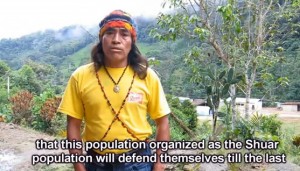 The Mirador Project includes a total of six open pit mining concessions encompassing almost 25,000 acres. According to the Global Alliance for the Rights of Nature (GARN), “Mirador’s open pit mines will eliminate all the vegetation and the superficial soil layer of the mined area including 4,000 species of vascular plants that contain the richest biodiversity in South America.”
The Mirador Project includes a total of six open pit mining concessions encompassing almost 25,000 acres. According to the Global Alliance for the Rights of Nature (GARN), “Mirador’s open pit mines will eliminate all the vegetation and the superficial soil layer of the mined area including 4,000 species of vascular plants that contain the richest biodiversity in South America.”
The project will have a severe impact on the Shuar, their culture and their sacred sites, not to mention the very water and land they depend on.
The threat to the Shuar started receiving headlines last month (at least in the United States) thanks to a timely article published at salon.com: “To get the gold, they will have to kill every one of us.”
Environmental, human rights, indigenous organizations, and local community members from the Condor region in Ecuador are taking legal action to stop the Mirador Project. GARN explains, “[The lawsuit] claims that the mine would violate the protected rights of ecosystems guaranteed in the Articles 71-73 on Rights of Nature in the Ecuadorian Constitution. The case is now being analyzed by the 25th Civil Court of Pichincha against the Ministry of Non Renewable Resources, the Ministry of Environment and Ecuacorriente with the plaintiffs asking to stop the Mirador Mining Project using the precautionary principle to guarantee Rights of Nature, Right to Water and Right to a Decent Life.”
In order to build up some momentum, a petition is also running in support of the lawsuit. You can sign that petition here.
Whether or not the petition reaches its target goal, and whether or not the court stands behind the Constitution by halting the Mirador Project, the Shuar will do everything in their power to defend the land they know and love.
Unlike President Correa, the Shuar do not rely on convenient moral notwithsanding clauses to justify the destruction of the natural world for the sake of a few dollar notes. There priorities are in order. They state them clearly and without apology.
(Gerri Haynes and Laura Hart, of Washington Physicians for Social Responsibility, have returned to Gaza, taking in medicine. Gerri has been sending back reports.)
The cab ride from Gaza City takes about ½ hour. The first stop is at the Hamas checkpoint where passports were checked and we were sent on our way. Since Pillar of Cloud, private cars or cabs coming from Gaza can no longer take passengers from the Hamas checkpoint to the departure from Gaza checkpoint – so a second cab is required for this ½ + mile.
At the departure checkpoint, further passport inspection is required and after about 10 minutes (briefer than usual) Laura and I were on our way to Erez – pulling our bags through the ½ mile cage/tunnel to the first set of doors. Through the doors to the first inspection of our luggage, to the first set of turnstiles – up a long sloped floor to another door, down a hall to the second set of turnstiles and into the first gathering room where all luggage/purses/cameras/computers, etc are surrendered to large white bins and an up-sloping conveyor belt that takes everything to an unseen place for an unknown amount of time.
And then the wait begins…ten to twenty people crowd into a small room behind a security-screening device – imagine your basic airport hands-up-in-the-air device and morph it into a more space age whirring-around-the-body device.
Today, Sunday, following the 36 hours of Erez weekend closure, there were dozens and dozens of people waiting to pass from Gaza. Many of these people were ill, many were children, many were mothers or fathers or grandparents accompanying an ill child or adult, some were businessmen. There is no line to enter the screening – everyone crowds into everyone else and some feel entitled to step in front of others.At one point, after about 30 minutes, I became impatient with healthy men who were crowding in front of women with sick children and I wedged myself between a group of these women and a group of the men – holding one woman after another in place to enter the screening … one elderly woman put her head on my shoulder and kept smiling at me until she was accepted into the screening.
At last, I followed that woman and when we had each completed the next phase of double screening (going back to be checked again in the device); I encountered her in a small open room (Israeli security people looking down at us.) We smiled at each other and hugged – at which point, I was loudly chastised and ordered into two further screening areas, including a partial disrobing search – what a morning!!
By the time, I cleared all of the multiple checks, Laura had gathered our luggage and we passed one-by-one through passport control, into the day and through the Erez fence.
Please note: Our passing is relatively easy – multiply the steps required for a Palestinian leaving Gaza.
By late morning, we arrived in Bethlehem and were greeted by our dear friend Zoughbi Zoughbi, Director of Wi’am. We reviewed some of our time in Gaza and then took a cab to Jericho to visit Zoughbi’s relatives.
As we approached Jericho, I mentioned that I had always wished to visit the monastery on the Mount of Temptation. With hardly a hesitation, we were climbing a rocky path up the mountain.
The view from there over Jericho to the Dead Sea and Jordan is spectacular. We were blessed with a clear, lightly sunny day and as we walked and talked about the future of Palestine, we were treated to a wonderful time for reflection.
Tomorrow, we’ll be talking more about the “next time” we come to Palestine and Israel – and then Laura and I will fly back to Washington. Each time I do this, I am reminded about the inequity of my freedom to travel vs. the incredible challenges faced by Palestinians who wish to travel.
Leaving the open-air prison of Gaza is a bit difficult but travel for Palestinians is plainly hard. Palestinians are stateless, they carry Palestinian identification, not a state-issued passport and many of the privileges of citizenship in a state do not pertain to them.
Most of the people we talked to here hold the hope that the recent UN vote will help to move the Palestinian people closer to having a place they call their state. I hope the next step for them is freedom – which as Yeshayahu Liebowitz, winner of the 1993 Israel prize stated, will only come with justice.
A final note – this is the hope of all my Israeli friends as well.
